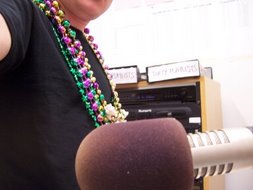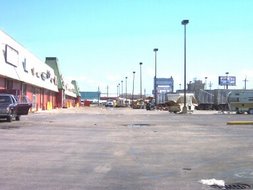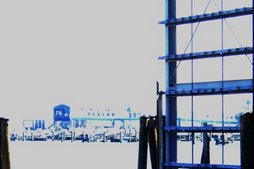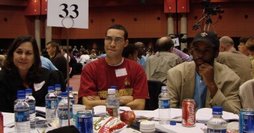
A town of loveable misfits trapped in a dome after a long-in-the-making environmental disaster, followed by an arbitrary, disastrous governmental response. The well-known landscape transformed into a devastated El Dorado, smashed windows, the rantings of passing madmen, national guard patrols. Desperation, violence, lawlessness.
Springfield, USA = New Orleans, LA.
Sitting in the AMC theater on the West Bank, we had a hard time deciding what was intentional and what was coincidental in the symbolism of the Simpsons movie. At times, I felt like heads nodded in knowing, rather than shaking in laughter. When the Dome settles down around the city and the citizens of Springfield are trapped with each other, well, that's a No Exit reality that everyone in the theater could imagine, or knew someone who lived through, or lived through themselves. When the Simpsons return to town after their escape and find the onslaught of urban apocalypse, we all saw that. The broken buildings and breakdown in society, there was something so very usual to them from a New Orleans perspective. Even the wild ramblings of bartender Moe, declaring himself in charge, bandanna around his head, he looked and sounded like something out of the parking lot camps or mayoral press conferences that sprouted up after the storm.
Probably a lot will be written (maybe already has, I didn't read the reviews) about the environmentalist lean to the movie's storyline, the way the characters took political shots at a variety of targets for short-sightedness and lack of preemptive action. That was all easy to see and I thought they pulled it off pretty well, though overall the movie was a little too direct in many ways, generally not as weird as the show. Going in, I was looking for that quirky dumbness and the sneaky satire, some comfort in the well-known devolution of family life.
But what crept in over and again was a feeling one sometimes gets when watching fictional accounts in the wake of the storm. What I'm speaking of is different than what we get when watching the sudden collapse of buildings in The Transformers, the helplessness of humans against larger forces that was (intentionally) reminiscent of 9/11. Then it's the thrill of vicarious threat, of "what it was like," perhaps the return, finally, of the attacker who left us waiting for more, a cinematic perversion of Stockholm Syndrome.
Instead, the familiarity with some scenes in the Simpsons movie elicits a response somewhere between a sympathetic shrug and a "whatever" shrug, i.e. nice cartoon, nice ending, check out our neighborhoods. By no means a resentment of representation, or lack of appreciation for the animated protest, but a feeling of permanence in the face of flashing image: in theaters across the country, that landscape appears and disappears; here, it was outside when we entered, and awaits us when we exit.
As stated, the parallels between the movie and real life during and after the storm were easy to see, and I'd hope American audiences take something from that.
But, at least for me, in New Orleans, the parallels drove home what a separate, trapped audience we remain. Not simply that life is stranger that fiction, but that fiction is stranger when seen from this life.











